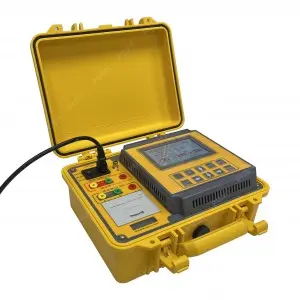- Understanding Turn Ratio Testers
Turn ratio testers are precision instruments used to measure the ratio of the number of turns in the primary winding to the number of turns in the secondary winding of a transformer. This ratio is critical in determining the transformer’s voltage transformation capabilities and ensuring its proper operation.

- Types of Turn Ratio Testers
There are two main types of turn ratio testers:
- Analog Turn Ratio Testers: These traditional testers utilize a moving coil meter to measure the voltage induced in the secondary winding when a known voltage is applied to the primary winding.
- Digital Turn Ratio Testers: Modern digital turn ratio testers employ advanced electronic circuitry and microprocessors to provide accurate and precise measurements. They often feature additional functionalities such as automatic range selection, data storage, and communication interfaces.
- Principles of Turn Ratio Testing
Turn ratio testing involves applying a known voltage to the primary winding of the transformer and measuring the voltage induced in the secondary winding. The ratio of these voltages is the turns ratio of the transformer. Digital turn ratio testers typically use sophisticated algorithms to calculate the turns ratio accurately, taking into account factors such as phase angle and frequency.
- Importance of Turn Ratio Testing
Turn ratio testing is crucial for several reasons:
- Accuracy Verification: It ensures that the transformer’s actual turns ratio matches the specified value, ensuring accurate voltage transformation.
- Quality Control: Turn ratio testing helps manufacturers identify and reject transformers with incorrect turns ratios, preventing potential failures in the field.
- Maintenance and Troubleshooting: Regular turn ratio testing during maintenance can detect winding faults, insulation problems, or other issues that may affect the transformer’s performance.
- Applications of Turn Ratio Testers
Turn ratio testers find extensive use in various industries and applications:
- Power Distribution: Testing of distribution transformers to verify their turns ratios and ensure proper voltage regulation.
- Power Generation: Evaluation of generator transformers to ensure accurate voltage transformation in power plants.
- Electrical Manufacturing: Quality control testing of transformers during production to meet industry standards and specifications.
- Maintenance and Repair: Testing of transformers during maintenance and repair procedures to identify potential problems.
- Three-Phase TTR (Turns Ratio) Testing
3 phase ttr transformers require special considerations during turn ratio testing. Three-phase TTR testers with ttr meter are designed to measure the turns ratios of three-phase transformers accurately, taking into account phase relationships and ensuring balanced voltage transformation.
- Safety Considerations
Turn ratio testing involves working with high voltages, so safety is paramount:
- Proper Training: Only trained and qualified personnel should conduct turn ratio testing.
- Grounding and Shielding: Adequate grounding and shielding measures should be implemented to prevent electrical hazards.
- Personal Protective Equipment (PPE): Appropriate PPE, such as insulated gloves and safety glasses, must be worn during testing.
- Test Area Access: The test area should be restricted to authorized personnel only.